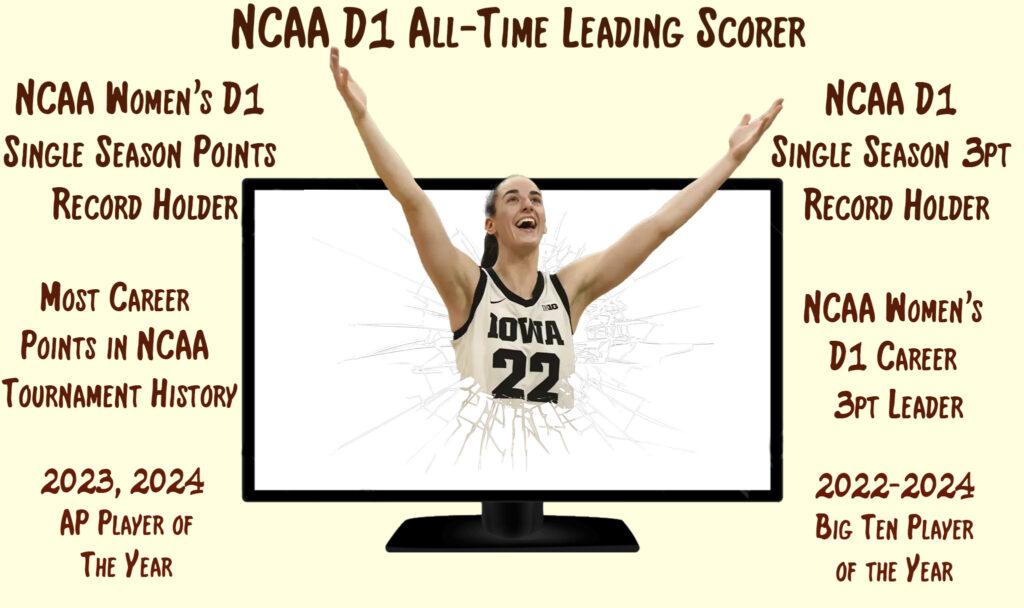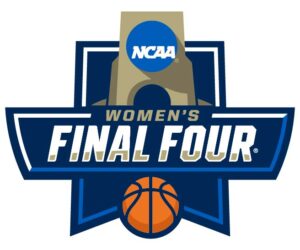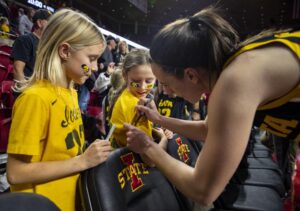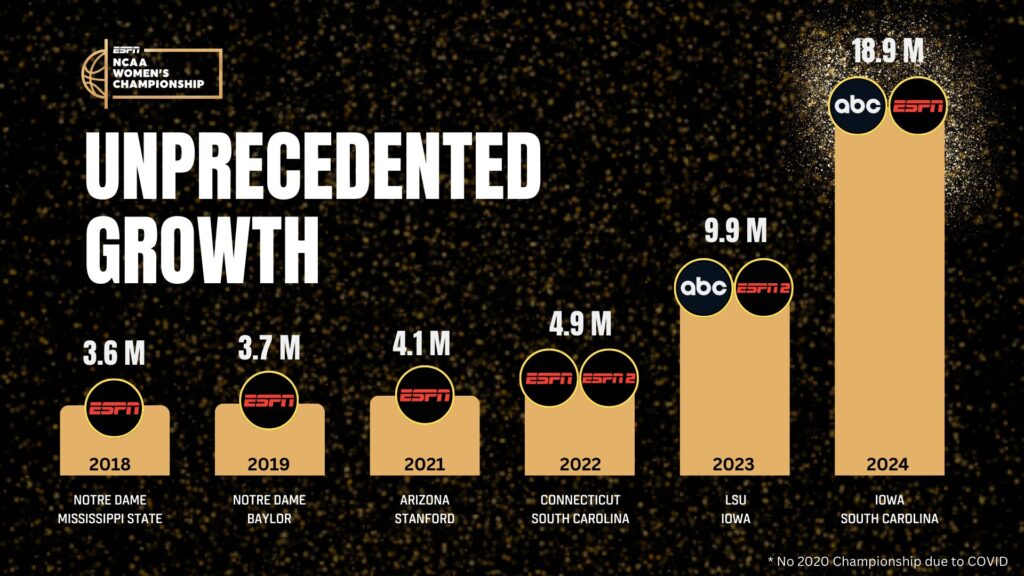
Caitlin Clark is reshaping the landscape of women’s basketball. Leading her Iowa Hawkeyes team to the championship game of the popular March Madness tournament in two consecutive years and breaking dozens of records along the way, Clark has grown the women’s game in unprecedented ways. Through what has been deemed as the “Caitlin Clark Effect,” Clark’s legacy is already stretching far beyond the scoring records she broke during her college career (Lobo 2024). Clark has drawn in an audience from across the country to eagerly tune into women’s basketball, with the 2024 championship game setting a record of a staggering 18.7 million viewers (Associated Press 2024).
Even with this undeniable growth in the world of women’s college basketball, why don’t we see similar viewership across all women’s sports, and why has there been such a historic lack of media coverage for female athletes?
Limited Coverage of Women’s Sports
Despite the talent, dedication, and achievements of female athletes, their experiences go largely unnoticed and uncaptured within the landscape of sports media. Newspapers only devote three percent of sports stories to women’s teams and five percent to individual female athletes. Similarly, women’s representation in sports makes up less than two percent of airtime on televised network news and ESPN’s SportsCenter (Schmidt 2016).
One possible explanation for this lack of coverage is that sports newsrooms are typically run by men (Sherwood, Osborne, Nicholson, and Sherry 2017). Since this is the case, men have the power to decide which sports deserve recognition and coverage. Thus, these male newsworkers decide that men’s sports have higher news value and justify this conclusion by assuming that their audience expects mostly coverage of male sports (Sherwood et al. 2017). Such coverage then furthers the problematic idea that women’s sports are less important and valued than men’s sports.
Gender Bias in the Media
Moreover, when covered in the media, female athletes are often designated as a less valued ‘other.’ For instance, broadcasters and journalists refer to female athletes by their first names more frequently than male athletes. Studies also show that labeling women’s sports with gender-specific terms, like “Women’s Final Four,” makes them seem less important compared to men’s sports (Schmidt 2016).

Despite progress in sports media regarding gender equity, it still often trivializes, sexualizes, or compares female athletes to male athletes. For example, television commentators often refer to female athletes as “girls,” while male athletes are rarely called “boys” (Schmidt 2016). Such language can diminish the achievements of female athletes and reinforce gender stereotypes.
Impacts of Media Neglect on Female Athletes
The lack of coverage for women’s sports directly contributes to and legitimizes the gender pay gap present in the world of sports. Across tennis, basketball, and soccer, female athletes earn far less than their male counterparts. Consequently, with the lack of media coverage and compensation for professional women’s sports, young girls may be less likely to consider sports as a viable career option. If such media trends continue, fewer girls might pursue sports professionally (Kluska 2023).

Additionally, sports media coverage often overlooks how race, gender, and sexual orientation intersect. Not only is it crucial to cover women in sports but important to highlight the diverse experiences they bring, including the unique challenges faced by women of color, LGBTQ+ athletes, and others (Bruce 2016). This recognition is essential for promoting equality and understanding the complexities of the sporting world.
Glimpses of Progress
Currently, a major transformation regarding media coverage for female athletes can be witnessed through the increased visibility of NCAA women’s basketball. Despite the popular men’s March Madness tournament receiving significantly more televised coverage, the women’s side of the tournament continues to break viewership records each year (Kane 2013).

These continuous record-setting numbers cannot be ignored as they display that there is a growing audience that is eager to consume women’s sports content. Namely, NCAA basketball player Caitlin Clark is emerging as a prominent figure in sports media, challenging the status quo and bringing much-needed attention to women’s sports via the “Caitlin Clark Effect” (Lobo 2024). This impact positions women’s basketball as a possible viable and lucrative career, as demonstrated by Clark’s visibility and media time.
Clark’s Iowa Hawkeyes sold out all of their home games this season, with their game against Ohio State marking the highest-ever ticket prices for a women’s basketball game. Even before the staggering viewership numbers during the March Madness tournament, seven streaming platforms and television networks set viewership records for women’s college basketball games when Iowa played on their air (Lobo 2024). This rise in popularity hints at a potential shift towards a more equitable and inclusive sports media landscape.
References
Associated Press. 2024. “NCAA Women’s Title Game Most Watched Hoops Game Since 2019.” ESPN. (https://www.espn.com/womens-college-basketball/story/_/id/39902902/ncaa-women-title-game-most-watched-hoops-game-2019).
Bruce, Toni. 2016. “New Rules for New Times: Sportswomen and Media Representation in the Third Wave.” Sex Roles 74(7-8):361-376. doi: https://doi.org/10.1007/s11199-015-0497-6.
Kane, Mary J. 2013. “The Better Sportswomen Get, the More the Media Ignore Them.” Communication & Sport, 1(3), 231-236. https://doi.org/10.1177/2167479513484579
Kluska, Michaela M. 2023. “The ongoing battle to end the gender pay gap in the world of professional tennis, basketball, and soccer and how the media remains the underlying issue.” Florida Entertainment and Sports Law Review, 2(2), 131-150. https://heinonline.org/HOL/P?h=hein.journals/fdaetnm2&i=142
Lobo, Rebecca. 2024. “Caitlin Clark’s Iowa Scoring Record and Legacy as College Career Ends.” ESPN. (https://www.espn.com/womens-college-basketball/story/_/id/39838971/caitlin-clark-iowa-scoring-record-legacy-college-career-ends).
Schmidt, Hans C. 2016. “Women’s sports coverage remains largely marginalized.” Newspaper Research Journal 37(3): 275-298. doi: https://doi.org/10.1177/0739532916663211
Sherwood, Merryn, Angela Osborne, Matthew Nicholson, and Emma Sherry. 2017. “Newswork, News Values, and Audience Considerations: Factors That Facilitate Media Coverage of Women’s Sports.” Communication & Sport, 5(6), 647-668. doi: https://doi.org/10.1177/2167479516645535